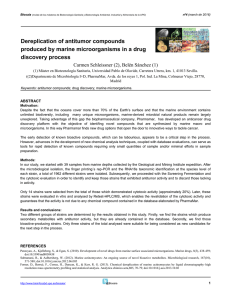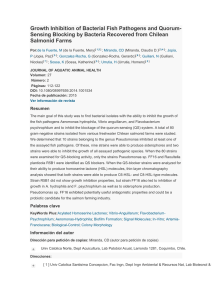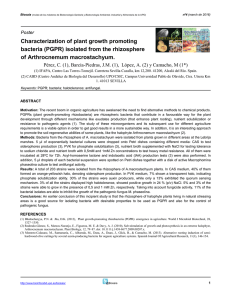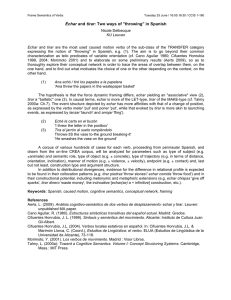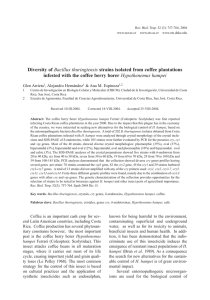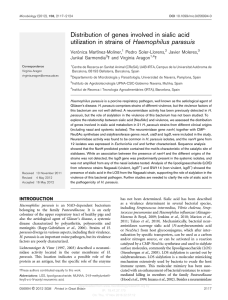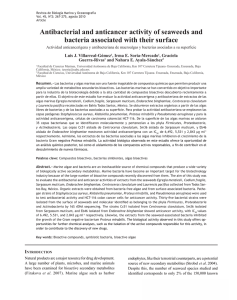Study of the expression of carotenoid biosynthesis genes
Anuncio
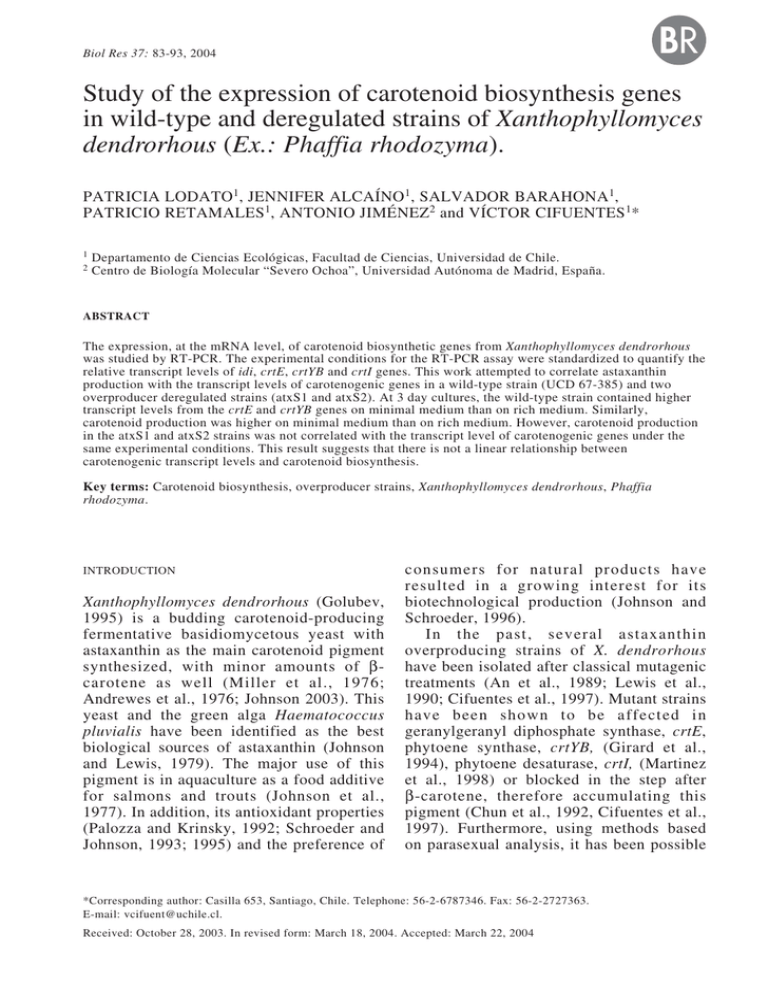
LODATO ET AL. Biol Res 37, 2004, 83-93 Biol Res 37: 83-93, 2004 BR83 Study of the expression of carotenoid biosynthesis genes in wild-type and deregulated strains of Xanthophyllomyces dendrorhous (Ex.: Phaffia rhodozyma). PATRICIA LODATO1, JENNIFER ALCAÍNO1, SALVADOR BARAHONA1, PATRICIO RETAMALES1, ANTONIO JIMÉNEZ2 and VÍCTOR CIFUENTES1* 1 2 Departamento de Ciencias Ecológicas, Facultad de Ciencias, Universidad de Chile. Centro de Biología Molecular “Severo Ochoa”, Universidad Autónoma de Madrid, España. ABSTRACT The expression, at the mRNA level, of carotenoid biosynthetic genes from Xanthophyllomyces dendrorhous was studied by RT-PCR. The experimental conditions for the RT-PCR assay were standardized to quantify the relative transcript levels of idi, crtE, crtYB and crtI genes. This work attempted to correlate astaxanthin production with the transcript levels of carotenogenic genes in a wild-type strain (UCD 67-385) and two overproducer deregulated strains (atxS1 and atxS2). At 3 day cultures, the wild-type strain contained higher transcript levels from the crtE and crtYB genes on minimal medium than on rich medium. Similarly, carotenoid production was higher on minimal medium than on rich medium. However, carotenoid production in the atxS1 and atxS2 strains was not correlated with the transcript level of carotenogenic genes under the same experimental conditions. This result suggests that there is not a linear relationship between carotenogenic transcript levels and carotenoid biosynthesis. Key terms: Carotenoid biosynthesis, overproducer strains, Xanthophyllomyces dendrorhous, Phaffia rhodozyma. INTRODUCTION Xanthophyllomyces dendrorhous (Golubev, 1995) is a budding carotenoid-producing fermentative basidiomycetous yeast with astaxanthin as the main carotenoid pigment synthesized, with minor amounts of βcarotene as well (Miller et al., 1976; Andrewes et al., 1976; Johnson 2003). This yeast and the green alga Haematococcus pluvialis have been identified as the best biological sources of astaxanthin (Johnson and Lewis, 1979). The major use of this pigment is in aquaculture as a food additive for salmons and trouts (Johnson et al., 1977). In addition, its antioxidant properties (Palozza and Krinsky, 1992; Schroeder and Johnson, 1993; 1995) and the preference of consumers for natural products have resulted in a growing interest for its biotechnological production (Johnson and Schroeder, 1996). In the past, several astaxanthin overproducing strains of X. dendrorhous have been isolated after classical mutagenic treatments (An et al., 1989; Lewis et al., 1990; Cifuentes et al., 1997). Mutant strains have been shown to be affected in geranylgeranyl diphosphate synthase, crtE, phytoene synthase, crtYB, (Girard et al., 1994), phytoene desaturase, crtI, (Martinez et al., 1998) or blocked in the step after β-carotene, therefore accumulating this pigment (Chun et al., 1992, Cifuentes et al., 1997). Furthermore, using methods based on parasexual analysis, it has been possible *Corresponding author: Casilla 653, Santiago, Chile. Telephone: 56-2-6787346. Fax: 56-2-2727363. E-mail: [email protected]. Received: October 28, 2003. In revised form: March 18, 2004. Accepted: March 22, 2004 84 LODATO ET AL. Biol Res 37, 2004, 83-93 to improve the production of astaxanthin after protoplast fusion of overproducing mutant strains (Chun et al., 1992; Girard et al., 1994). However, these techniques have been exploited to the limit and attempts to increase astaxanthin production in this yeast have to involve new advances in the molecular biology of the biosynthesis pathway. In X. dendrorhous, the carotenoid controlling genes to the β-carotene step have been isolated in the last few years (Verdoes et al., 1999; Verdoes et al., 1999b; Alcaíno et al, 2001). On the other hand, there are studies about the influence of some environmental factors on carotenoid production by X. dendrorhous. Some of these factors include oxygen and glucose concentration (Yamane et al., 1997), light (An et al., 1990) and culture conditions (Vázquez and Santos, 1998; Ducrey and Kula, 1998). However, no data are available on the expression of specific astaxanthin controlling genes at the mRNA level, as it was established for other eukaryotic organisms. In this respect, in plants, fungi and algae, a relationship between mRNA levels of carotenogenic genes and carotenoid production have been described (Ruiz-Hidalgo et al., 1997; Hirschberg, 1998; Sun et al., 1998; Arrach et al., 2001). In the present work, we isolated an overproducing mutant after classical mutagenic treatment, and developed an RTPCR assay to investigate the expression of specific carotenoid controlling genes in the wild-type and deregulated strains in different culture conditions. MATERIALS AND METHODS Yeast strains and culture conditions. X. dendrorhous diploid strain UCD 67385 (ATCC 24230) was used as the wildtype (Hermosilla et al., 2003). The phylogenetic relationship of UCD 67-385 to other lineages of this yeast have been described by Fell & Blatt (1999) after the sequence analyses of ribosomal DNA internal transcribed spacer (ITS) and intergenic spacer (IGS) regions. The wild-type UCD 67-385 was mutagenised using N-methyl-N´-nitro-nitrosoguanidine (NTG) treatment (40 µg/ml), in the conditions described before (Cifuentes et al., 1997). A highly pigmented colony was selected by visual inspection and it was resuspended in distilled water. This suspension was plated on YM (An et al., 1989) and a highly pigmented colony, named atxS2, was analysed for carotenoid production and pigment composition. The atxS2 cultures produced about 2.230 mg of total carotenoid per g of dry yeast and HPLC analysis of carotenoids indicate that the principal pigment was astaxanthin. The wild-type and mutant strains were grown at 22 °C with constant shaking, in 250 Erlenmeyer flasks containing 50 ml of YM or the minimal medium (MM) described by Yamane et al. (1997), with sodium nitrate at 1.29 g l -1 used as a nitrogen source instead of ammonium sulphate. The MMv (Retamales et al., 2002) using 2% glucose as a carbon source was the growth medium employed to obtain the cells which were subjected to the protoplast formation and fusion procedure as previously described (Retamales et al., 1998; 2002). Carotenoid extraction and analysis Total carotenoids were extracted according to An et al. (1989). Their concentrations were calculated using a 1 % absorption coefficient of 2100 and the maximal peak absorbance value at 474 nm. The carotenoids were dissolved in hexane and separated by HPLC on a LUNA 3 silica column (Phenomenex, 150 x 4.60 mm) at 1 ml/min and 20 °C. The mobile phase was hexane:acetone (86:14 v/v) in isocratic conditions. The spectra were recorded directly from elution peaks using a 996 photodiode detector (Waters). Astaxanthin and β-carotene were identified based on their absorption spectra and retention times, as compared to authentic standards (Sigma and Roche, respectively). LODATO ET AL. Biol Res 37, 2004, 83-93 Total RNA purification of X. dendrorhous: Cells were harvested by centrifugation at 5,900 x g for 10 min, frozen in liquid nitrogen and then stored at –70 ºC until processing. The RNA extraction was performed using TRIzol Reagent (Gibco BRL) as described elsewhere (Chomczynski and Sacchi, 1987) and modified for X. dendrorhous as follows. To the cellular material, 3 to 5 ml of Chomczynski solution in phenol (Ch-P solution) were added followed by one volume of glass beads (Sigma, 425 - 600 µm). Cellular breakage was performed by shaking on a vortex at maximum speed for 10 min. The mixture was incubated for 10 min at room temperature followed by the addition of 0.2 ml of chloroform for each ml of Ch-P solution, shaking and an incubation at room temperature for 5 min. After centrifugation at 12,100 x g, the RNA in the aqueous phase was transferred to a sterile tube, and 1 volume of isopropanol was added. After incubation for 10 min at room temperature the RNA was precipitated by centrifugation at 12,100 x g for 10 min at 4 °C. The RNA pellet was washed with 1 ml of 75% ethanol. The RNA was resuspended in water (DEPC treated), and then stored at -20 °C. Total RNA concentration was determined spectrophotometrically at 260 nm, and aliquots of the extracts were subjected to denaturing agarose gel electrophoresis to check RNA integrity. Synthesis of single stranded cDNA by reverse transcription (RT reaction): The RNA samples were previously treated with 1U/µl of DNase I (RNase free, Roche) in 2.5 mM MgCl 2 for 30 min at 25 ºC. Reactions were terminated by addition of EDTA to a final concentration of 2.5 mM and heating at 65 ºC for 15 min. The reverse transcription reaction was performed in a final volume of 25 µl containing between 3 to 9 µg of total RNA, 75 pmol of oligo dT15, 0.5 mM dNTPs and 200 U of M-MLV reverse transcriptase H minus (Promega). The reaction mixture was incubated 60 min at 42 °C and then heated 10 min at 65 °C. 85 Amplification by PCR of cDNA from the RT reaction: The PCR amplification was performed in a final volume of 25 µl containing: 2.5 µl of 10 x Taq buffer, 0.5 µl of dNTPs 10 mM, 1 µl of MgCl2 50 mM, 1 µl of each 25 mM primers, 2 µl of RT reaction, 2 U Taq pol (Promega) and water. The amplification was performed in a Perkin Elmer 2400 equipment with the following program: 95 ºC for 3 min, 28 cycles of 94 oC for 30 s, 55 oC for 30 s, 72 oC for 3 min, and a final extension of 72 oC for 10 min. For the quantification of RT-PCR products, all PCR amplifications were made by triplicate and were standardized for the volume of reaction used, total RNA concentration and number of amplification cycles. In the quantification of RT-PCR products, equal volumes of PCR reactions were loaded on 1 % agarose gels containing ethidium bromide. After agarose gel electrophoresis, the mass of the bands was quantified using Φ29/HindIII as a molecular weight standard of known concentration by Kodak Digital Science 1D Image Analysis Software. Only those bands whose intensity was not oversaturated were considered for quantification. To normalize for sample-tosample variation in RT and PCR efficiency, relative values were obtained by comparing the intensity of the carotenoid gene product bands with the intensity of the actin product band used as a control. The primers were designed according to the published sequences of genes idi, crtE, crtYB, crtI (Kajiwara et al., 1997; GenBank accession number A63889; Verdoes et al., 1999a; 1999b) and the sequences of the genes crtI (León, 2000) and crtYB (Alcaíno, 2002) from a genomic library of the wild-type UCD 67-385 strain. The genomic library of the UCD 67-385 strain has been constructed in the BamHI restriction site of the Bluescript SK- plasmid (Martínez, 1995; Martínez et al., 1998). Primers of the actin encoding gene (act) from X. dendrorhous were designed according to published sequences (Wery et al., 1996). The forward primers (sense) were designed to contain sequences of two adjacent exons as shown in table I. LODATO ET AL. Biol Res 37, 2004, 83-93 86 TABLE I Primers used in RT-PCR to determine the mRNA level of carotenogenesis genes. Gene Primers Expected size of products act Exon IV Exon V F 5´actcctacgttggtgacgag 3´ R 5´cactttcggtggacgatgga 3´ Exon V 970 pb crtI Exon VI Exon VII F 5´ccacttccacgagaagagac 3´ R 5´aacggatcgagcgatcacgg 3´ Exon XII 1441 pb crtE Exon I Exon II F 5´ttcagtcttctgagtatgccc 3´ R 5´cattgcgagaagacgaagact 3´ Exon III 685 pb idi Exon I Exon II F 5´tacgatgaggagcaggtcag 3´ R 5´ccgagagatcctccaacgat 3´ 670 pb crtYB Exon IV Exon V F 5´ggctggttggactatacgca 3´ R 5´caatagctcggcgactgagc 3´ Exon V 485 pb F: forward primer; R: reverse primer. In forward primers, the 3’ end of the first exon (underlined) and the 5’ end of the second exon on the boundary exon-exon are shown. RESULTS AND DISCUSSION Mutagenesis and selection of the axtS2 strain. After nitrosoguanidine treatment of X. dendrorhous strain UCD 67-385, several colonies with higher levels of astaxanthin production as compared to the parental strain were obtained. The mutagenic treatment using NTG produces color mutants with a mutation frequency of 8.6 x 10 -4 and over 80 % of these mutants overproduce astaxanthin (Retamales et al., 1998). A colony was selected based on its highest carotenoid production in relation to the wild-type and its stability after repeated transfers on YM or MMv (Table II). This strain named atxS2, has a spontaneous reversion rate of less than 10 -6 as determined by repeated plating on YM agar. The analysis of carotenoid composition at 3 days of growth in YM, indicates that astaxanthin was the principal pigment (72 % of total carotenoids) (Fig. 1). A complementation assay was performed by fusion of protoplasts obtained from strains atxS2 and atxS1, the latter being an astaxanthin overproducing mutant of strain UCD 67-385 (Cifuentes et al., 1997). The resulting fusants showed a phenotype like that of the wild-type, suggesting that atxS1 and atxS2 strains carry different mutations. RT-PCR. assay The reverse transcriptase -polymerase chain reaction (RT-PCR) amplification assay has been employed to analyze transcript levels of carotenogenic genes in plants (Giuliano LODATO ET AL. Biol Res 37, 2004, 83-93 87 TABLE II Carotenoids production at three days of cultivation in MM and YM. Strain Carotenoids (mg/g) MM Carotenoids (mg/g) YM UCD 67-385 232.1 ± 9.67 86.1 ± 1.45 atxS1 850.2 ± 41.80 680.7 ± 61.40 atxS2 538.5 ± 22.0 398.5 ± 3.13 Figure 1. HPLC separation of carotenoid pigments extracted from atxS2 cells of 3-day-old cultures in YM. The carotenoids identified were β-carotene (peak 1), all-trans-astaxanthin (peak 2), 9-cisastaxanthin (peak 3) and 13-cis-astaxanthin (peak 4). et al., 1993; Bartley and Scolnik, 1993) and in the alga Haematococcus pluvialis (Grünewald, 2000) due to its level of sensitivity to detect rare transcripts. In this work we standardized an RT-PCR procedure to study transcript levels of carotenogenesis genes, idi, crtI, crtE and crtYB of X. dendrorhous. For this purpose, primers for carotenoid biosynthetic genes and the actin gene were designed from published genomic DNA sequences and the sequences of the genes crtI (León, 2000) and crtYB (Alcaíno, 2002) from the wildtype strain UCD 67-385. One primer (forward) of each pair was placed on different adjacent exons within a gene to avoid amplification from minute quantities of genomic DNA. The expected fragment length of each RT-PCR product is shown in table I. The transcript level of act gene was employed to normalize for sample-tosample variation and to determine the relative amount of carotenogenic trancripts in different conditions and strains. Under the conditions described above, only one band was observed for each transcript (Fig. 2A) and more than one carotenogenic mRNA in one RT-PCR reaction could be co-amplified simultaneously using four pairs of specific primers (Fig. 2B). The conditions of RT-PCR reactions were standardized for the volume of RT reaction employed in the PCR, the cycle number, and the amount of total RNA in RT. To 88 LODATO ET AL. Biol Res 37, 2004, 83-93 Figure 2. RT-PCR amplification of idi, crtE, crtYB, crtI and act transcripts. Equal volumes of PCR reactions were loaded on a 1 % agarose gel and stained with ethidium bromide. M, Marker (100 bp). (A) Lanes 1-4, act (970 bp); Lane 1, idi (670 bp); Lane 2, crtYB (485 bp); Lane 3, crtYB (728 bp); Lane 4, crtE (685 bp), predicted fragment sizes in base pairs are indicated in parenthesis. (B) Co-amplification of crtI, act, idi and crtYB transcripts. determine the effect of increasing the volume of the reverse transcription reaction (single stranded cDNA) in the RT-PCR assay, act and crtI genes were simultaneously amplified using volumes between 0.5 to 3 µl. The results indicated that the DNA yield from each gene was proportional to the increase of single stranded cDNA quantity (Fig. 3A and B). To determine the number of amplification cycles required to obtain an exponential accumulation of products, a calibration curve was performed with a different number of amplification cycles using total RNA and two pairs of primers to detect act and idi transcripts respectively. The results indicate that products accumulate exponentially up to amplification cycle 31 (Fig. 3C), and at 28 cycles it was possible to obtain a quantitative response. The effect of total RNA concentration in the RT reaction on the final production of specific DNA bands after 28 cycles of amplification in the PCR for act, crtI, crtE, idi and crtYB genes was studied. The results show that the intensity of the RT-PCR products of the five genes studied was proportional to the amount of input RNA in RT reactions (Fig. 4A and B). The response obtained is semilogarithmic as was shown by Giuliano et al. (1993). These authors quantified RT-PCR products after ethidium bromide staining, although after 9 µg of total RNA the amplification products decayed visibly and were no longer quantitative. Thus a volume of 2 µl of RT reaction containing 3 µg of total RNA were used in most experiments with 28 cycles of amplification. Carotenoids biosynthetic gene expression on wild-type and mutants strains. With this procedure it was possible to detect carotenogenic gene transcripts in mutant and wild-type strains under different nutritional conditions (Fig. 5). The relative level of carotenogenic transcripts in relation to act transcript levels was determined for the wild-type, atxS1 and atxS2 strains at 3 days of growth on YM and MM media. In the wild-type, the relative transcript level of crtE and crtYB genes were higher on MM than on YM (Fig. 5A). However, there was no significant difference for relative transcript levels in the deregulated strains (Fig. 5B and C). Concerning carotenoid production, the ratio betweeen MM and YM at 3 days was 2.7 for wild-type, yet only 1.2 and 1.4 for atxS1 and atxS2 respectively LODATO ET AL. Biol Res 37, 2004, 83-93 89 A B C Figure 3. RT-PCR amplifications were standardized for the volume of RT reaction employed (single stranded cDNA) and the number of cycles. (A) M, Marker (100 bp). act and crtI transcripts were amplified for 28 cycles employing the following volumes of RT reactions in PCR: 0.5 µl (lane 1), 1 µl (lane 2), 2 µl (lane 3), 2.5 µl (lane 4) and 3 µl (lane 5). (B) Quantification of bands in part A corresponding to act (❍) and crtI (■) cDNA was done by Kodak Digital Science 1D Software. (C) act (❍) and idi (▲) cDNA amplification with different number of cycles, 2 µl of RT reactions were employed for each point of the curve. 90 LODATO ET AL. Biol Res 37, 2004, 83-93 A B Figure 4. Quantification of RT-PCR products after 28 cycles of amplification with different amounts of total input RNA in RT reactions (1.4 µg, 2.8 µg, 5.6 µg, 8.4 µg and 14 µg). (A) act (❍), crtI (■), crtE (*). (B) idi (▲), crtYB (∆). (Table II). Thus, one of the reasons for the difference in carotenoid production on the two media for the wild-type, would be differences in the crtE and crtYB transcript levels. There is also a relationship between carotenogenesis and mRNA levels of geranylgeranyl-pyrophosphate synthase (al- 3 gene) and phytoene synthas-lycopene cyclase (al-2 gene) of Neurospora crassa as a response to blue light (Carattoli et al., 1991; Schmidhauser et al., 1994). On the other hand, similar carotenogenic transcript levels detected in the overproducing strains, atxS1 and atxS2, in the two media could LODATO ET AL. Biol Res 37, 2004, 83-93 explain the lower difference in carotenoid production. This could be due to the carotenoid biosynthesis being deregulated and therefore insensitive to change in environmental factors such as culture media (Fig. 5B and C). Another possibility would 91 be that subtle differences between levels of mRNA exist, which are out of the detection limit of this method. However, as the difference in carotenoid production between wild-type and mutants could not be explained by a difference in carotenogenic A B C Figure 5. Relative expression of carotenogenesis transcripts at 3 days of growth on MM and YM for the wild-type (A), atxS1 (B) and atxS2 (C) strains. 92 LODATO ET AL. Biol Res 37, 2004, 83-93 transcript levels at three days of cultivation, sampling at different stages of the yeast growth cycle would be a necessary approach (Lodato et al, 2002). Our preliminary results indicate that carotenogenic mRNA levels decrease during stationary phase on YM, except for crtE gene, (Lodato et al, 2003). At present, we are performing experiments analyzing the transcript levels at different time points including the ast gene (GenBank accession number, AX034666) which is involved in the conversion of β-carotene to astaxanthin. ACKNOWLEDGEMENTS This work was supported by Grant D.I.D Enlace 2000/17, PG/6/2001, Depto de Postgrado y Postítulo, Universidad de Chile, by Fondecyt 1040450 and by Acciones Integradas agreement between Universidad de Chile (Chile) and C.S.I.C. (Spain), Fundación María Ghilardi Venegas by a graduate scholarship to P. Retamales and Deutscher Akademischer Austanschdienst (DAAD) by a graduate scholarship to P. Lodato. REFERENCES ALCAÍNO J (2002) Organización estructural del gen de la fitoeno sintasa en el genoma de Xanthophyllomyces dendrorhous (ex Phaffia rhodozyma). Engineer in Biotechnology Thesis, University of Chile. ALCAÍNO J, BARAHONA S, CIFUENTES V. (2001) Structural organization of the phytoene synthaselycopene cyclase gene (crtYB) of Xanthophylomyces dendrorhous. Biol Res 34: R209 AN GH, SCHUMAN DB, JOHNSON EA (1989) Isolation of P. rhodozyma mutants with increased astaxanthin content. Appl. Environ. Microbiol. 55: 116-124. AN GH, JOHNSON EA (1990) Influence of light on growth and pigmentation of the yeast Phaffia rhodozyma. Antonie van Leeuwenhoek. 57: 191-203. ANDREWES AG, PHAFF HJ, STARR MP (1976) Carotenoids of P. rhodozyma, a red pigmented fermenting yeast. Phytochemistry. 15: 1003-1007. ARRACH N, FERNÁNDEZ-MARTIN R, CERDAOLMEDO E, ÁVALOS J (2001) A single gene for lycopene cyclase, phytoene synthase and regulation of carotene biosynthesis in Phycomyces. Proc. Natl. Acad. Sci. USA 98: 1687-1692. BARTLEY G, SCOLNIK P (1993) cDNA cloning, expression during development, and genome mapping of PSY2, a second tomato gene encoding phytoene synthase. J. Biol. Chem. 268: 25718-25721. CARATTOLI A, ROMANO N, BALLARIO P, MORELLI G, MACINO G (1991) The Neurospora crassa carotenoid biosynthetic gene (Albino 3) reveals highly conserved regions among prenyltransferases. J. Biol. Chem. 266: 5854-5859. CHOMCZYNSKI P, SACCHI N (1987) Single-step method of RNA isolation by acid guanidinium thiocyanatephenol-chloroform extraction. Anal. Biochem. 162: 156-159. CHUN SB, CHIN JE, BAI S, AN GH (1992) Strain improvement of P. rhodozyma by protoplast fusion. FEMS Microbiol. Lett. 93: 221-226. CIFUENTES V, HERMOSILLA G, MARTÍNEZ C, LEÓN R, PINCHEIRA G, JIMÉNEZ A (1997) Genetics and electrophoretic karyotyping of wild-type and astaxanthin mutant strains of Phaffia rhodozyma. Antonie van Leeuwenhoek 72: 111-117. DUCREY SANTOPIETRO LM, KULA MR (1998) Studies of astaxanthin biosynthesis in Xanthophyllomyces dendrorhous (Phaffia rhodozyma). Effect of inhibitors and low temperature. Yeast 14: 1007-1016. FELL JW, BLATT GM (1999) Separation of strains of the yeasts Xanthophyllomyces dendrorhous and Phaffia rhodozyma based on rDNA IGS and ITS sequence analysis. J. Indust. Microbiol. 23: 677-681. GIRARD P, FALCONNIER B, BRICOUT J, VLADESCU B (1994) β-carotene producing mutants of Phaffia rhodozyma. Microbiol. Biotechnol. 41: 183-191. GIULIANO G, BARTLEY GE, SCOLNIK PA (1993) Regulation of carotenoid biosynthesis during tomato development. Plant Cell 5: 379-387. GOLUBEV W (1995) Perfect state of Rhodomyces dendrorhous (X. dendrorhous). Yeast 11: 101-110. GRÜNEWALD K, ECKERT M, HIRSCHBERG J, HAGEN C (2000) Phytoene desaturase is localized exclusively in the chloroplast and up-regulated at the mRNA level during accumulation of secondary carotenoids in Haematococcus pluvialis (Volvocales, Chlorophyceae). Plant Physiol. 122: 1261-1268. HERMOSILLA G, MARTÍNEZ C, RETAMALES P, LEÓN R, CIFUENTES V (2003) Genetic determination of ploidy level in Xanthophyllomyces dendrorhous. Antonie van Leeuwenhoek 84:279-287. HIRSCHBERG J (1998) Molecular Biology of Carotenoid Biosynthesis. In: Britton G, Liaaen-Jensen S & Pfander H (Eds) Carotenoids, Vol 3 (pp 177-180). Birkhäuser Verlag, Berlin. JOHNSON EA (2003) Phaffia rhodozyma: Colorful odyssey. Int Microbiol 6: 169-174 JOHNSON EA, CONKLIN D, LEWIS MJ (1977) The yeast P. rhodozyma as a dietary pigment source for salmonids and crustaceans. J. Fish. Beast. Board Can. 34: 2417-2421. JOHNSON EA, LEWIS M (1979) Astaxanthin formation by the yeast P. rhodozyma. J. Gen. Microbiol. 115: 173-183. JOHNSON EA, SCHROEDER W (1996) Astaxanthin from the yeast Phaffia rhodozyma. Stud. Mycol. 38: 81-91. KAJIWARA S, FRASER PD, KONDO K, MISAWA N (1997) Expression of an exogenous isopentenyl diphosphate isomerase gene enhances isoprenoid biosynthesis in Escherichia coli. Biochem. J. 324: 421-426. LEÓN R (2000) Caracterización de determinantes genéticos de la síntesis de astaxantina en Xanthophyllomyces dendrorhous (ex Phaffia rhodozyma). Ph. D Thesis, University of Chile. LEWIS MJ, RAGOT N, BERLANT MC, MIRANDA M (1990) Selection of astaxanthin-overproducing mutants of P. rhodozyma with β-ionona. Appl. Environ. Microbiol. 56: 2944-2945. LODATO P, BARAHONA S, CIFUENTES V (2002) Analysis of the expression of astaxanthin biosynthetic genes from Xanthophyllomyces dendrorhous. Biol Res 35: R109 LODATO ET AL. Biol Res 37, 2004, 83-93 LODATO P, ALCAÍNO J, BARAHONA S, RETAMALES P, CIFUENTES V. (2003) Alternative splicing of transcripts from crtI and crtYB genes of Xanthophyllomyces dendrorhous. Appl. Environ. Microbiol. 69:4676-4682 MARTÍNEZ C. (1995) Control genético de la síntesis de carotenos en Phaffia rhodozyma. Ph.D. Tesis, Universidad de Chile. MARTÍNEZ C, HERMOSILLA G, LEÓN R, PINCHEIRA G, CIFUENTES V (1998) Genetic transformation of astaxanthin mutant strains of P. rhodozyma. Antonie van Leeuwenhoek. 73: 147-153. MILLER MW, YONEYAMA M, SONEDA M (1976) Phaffia, to new yeast genus in the Deuteromycotina (Blastomycetes). Int. J. Syst. Bacteriol. 26: 286-291. PALOZZA P, KRINSKY N (1992) Astaxanthin and canthaxanthin are potent antioxidants in a membrane model. Arch. Biochem. Biophys. 297: 291-295. RETAMALES P, LEÓN R, MARTÍNEZ C, HERMOSILLA G, PINCHEIRA G, CIFUENTES V (1998) Complementation analysis with new genetics markers in P. rhodozyma. Antonie van Leeuwenhoek. 73: 229-236. RETAMALES P, HERMOSILLA G, LEÓN R, MARTÍNEZ C, JIMÉNEZ A, CIFUENTES V (2002) Development of the sexual reproductive cycle of Xanthophyllomyces dendrorhous. J. Microbiol. Methods 48: 87-93. RUIZ-HIDALGO MJ, BENITO EP, SANDMANN G, ESLAVA AP (1997) The phytoene dehydrogenase gene of Phycomyces: regulation of its expression by blue light and vitamin A. Mol. Gen. Genet. 253: 734-744. SCHROEDER WA, JOHNSON EA (1993) Antioxidant role of carotenoids in Phaffia rhodozyma. J. Gen. Microbiol. 139: 907-912. SCHROEDER WA, JOHNSON EA (1995) Singlet oxygen and peroxyl radicals regulate carotenoid biosynthesis in Phaffia rhodozyma. J. Biol. Chem. 270: 18374-18379. 93 SCHMIDHAUSER TJ, LAUTER FR, SCHUMACHER M, ZHOU W, RUSSO VEA, YANOFSKY C (1994) Characterization of al-2, the phytoene synthase gene of Neurospora crassa. Cloning, sequence analysis, and photoregulation. J. Biol. Chem. 269: 12060-12066. SUN Z, CUNNINGHAM FX, GANTT E (1998) Differential expression of two isopentenyl pyrophosphate isomerases and enhanced carotenoid accumulation in an unicellular chlorophyte. Proc. Natl. Acad. Sci. USA 95: 11482-11488. VÁZQUEZ M, SANTOS V (1998) 3-Hydroxy-3’, 4’d i d e h y d r o - β - ψ- c a r o t e n - 4 - o n e ( H D C O ) f r o m Xanthophyllomyces dendrorhous (Phaffia rhodozyma) cultivated on xylose media. Biotechnol. Lett. 20: 181-182. VERDOES JC, KRUBASIK KP, SANDMANN G, VAN OOYEN AJ (1999a) Isolation and functional characterisation of a novel type of carotenoid biosynthetic gene from Xanthophyllomyces dendrorhous. Mol. Gen. Genet. 262: 453-461. VERDOES JC, MISAWA N, VAN OOYEN AJ (1999b) Cloning and characterization of the astaxanthin biosynthetic gene encoding phytoene desaturase of Xanthophyllomyces dendrorhous. Biotechnol. Bioeng. 63: 750-755. WERY J, DALDERUP MJM, TER LINDE J, VAN OOYEN AJJ (1996) Structural and phylogenetic analysis of the actin gene from the yeast Phaffia rhodozyma. Yeast 12: 641-651. YAMANE Y, HIGASHIDA K, NAKASHIMADA Y, KAKIZONO T, NISHIO N (1997) Influence of oxygen and glucose on primary metabolism and astaxanthin production by Phaffia rhodozyma in batch and fed-batch cultures: Kinetic and stoichiometric analysis. Appl. Environ. Microbiol. 63: 4471-4478.
